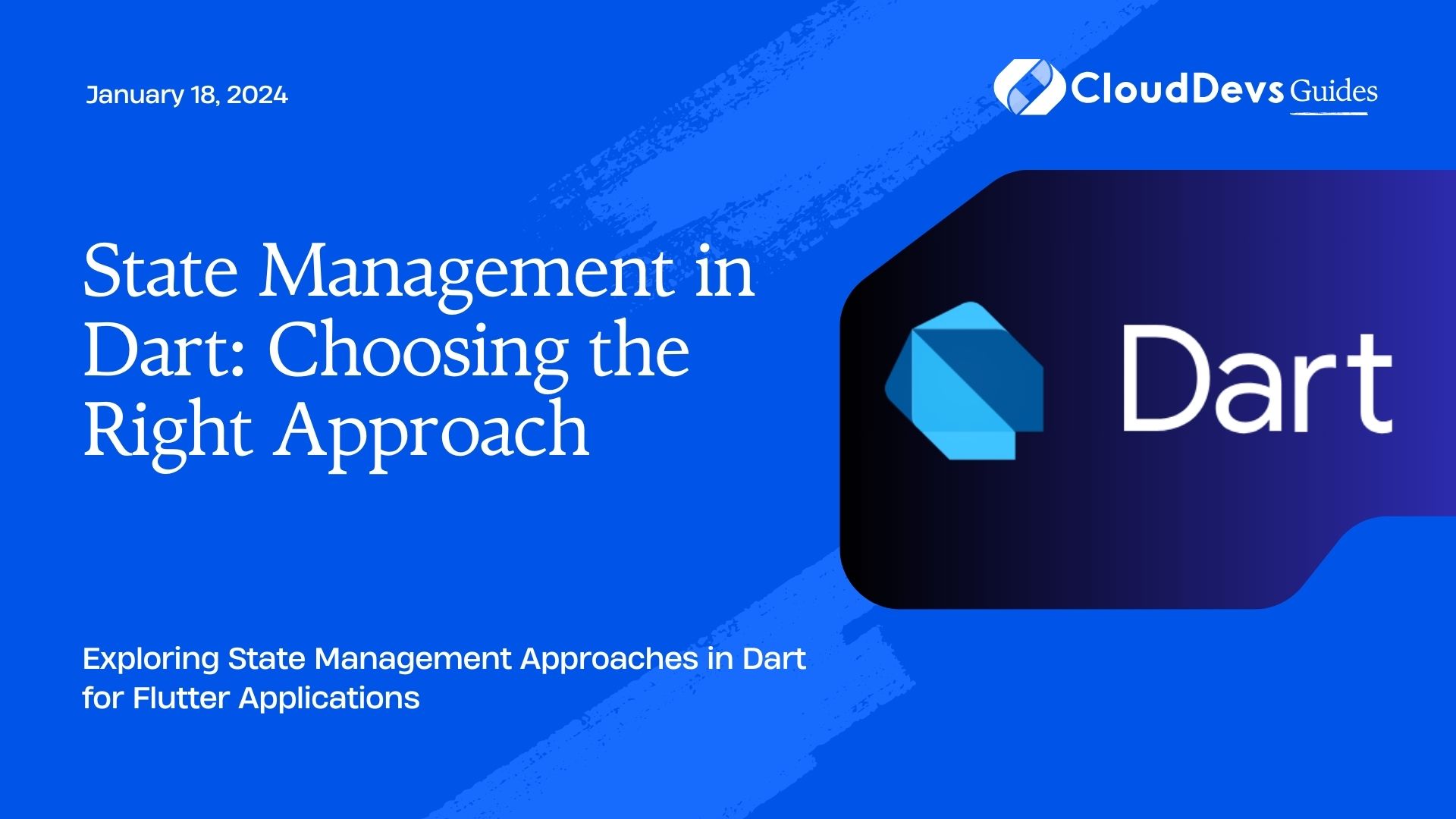State Management in Dart: Choosing the Right Approach
State management is a crucial aspect of developing robust and efficient applications, regardless of the programming language or framework you’re using. In Dart, a language known for its usage in creating cross-platform applications using Flutter, choosing the right state management approach can greatly impact the architecture and performance of your app. With a multitude of options available, each catering to different scenarios and developer preferences, it’s essential to understand the strengths and weaknesses of each approach before making a decision. In this blog post, we’ll delve into some of the popular state management approaches in Dart and help you choose the one that best suits your project’s needs.

Table of Contents
1. Introduction to State Management
State management involves controlling and maintaining the data that drives the user interface of your application. In Dart, managing state becomes paramount when developing complex applications that require dynamic updates and interactions. Different state management approaches offer varying degrees of control, reactivity, and scalability. Let’s explore some of these approaches:
2. The setState Method
When developing Flutter applications, the setState method is the simplest way to manage state. It’s suitable for small applications or components where the state changes are minimal. However, as your application grows, the setState method can lead to code that’s hard to maintain and understand.
dart
class CounterApp extends StatefulWidget {
@override
_CounterAppState createState() => _CounterAppState();
}
class _CounterAppState extends State<CounterApp> {
int _counter = 0;
void _incrementCounter() {
setState(() {
_counter++;
});
}
@override
Widget build(BuildContext context) {
return Scaffold(
appBar: AppBar(
title: Text('Counter App'),
),
body: Center(
child: Column(
mainAxisAlignment: MainAxisAlignment.center,
children: <Widget>[
Text('Counter:', style: TextStyle(fontSize: 24)),
Text('$_counter', style: TextStyle(fontSize: 48)),
],
),
),
floatingActionButton: FloatingActionButton(
onPressed: _incrementCounter,
tooltip: 'Increment',
child: Icon(Icons.add),
),
);
}
}
3. Provider
Provider is a popular state management solution that comes with the Flutter framework. It’s built around the concept of InheritedWidgets and allows you to manage and share state across your widget tree efficiently. Provider is suitable for both small and medium-sized applications and offers a good balance between simplicity and scalability.
dart
void main() {
runApp(
ChangeNotifierProvider(
create: (context) => CounterProvider(),
child: MyApp(),
),
);
}
class CounterProvider with ChangeNotifier {
int _counter = 0;
int get counter => _counter;
void increment() {
_counter++;
notifyListeners();
}
}
class MyApp extends StatelessWidget {
@override
Widget build(BuildContext context) {
return MaterialApp(
title: 'Provider Example',
home: Scaffold(
appBar: AppBar(
title: Text('Provider Example'),
),
body: Center(
child: Column(
mainAxisAlignment: MainAxisAlignment.center,
children: <Widget>[
Text('Counter:', style: TextStyle(fontSize: 24)),
Consumer<CounterProvider>(
builder: (context, provider, child) {
return Text('${provider.counter}', style: TextStyle(fontSize: 48));
},
),
],
),
),
floatingActionButton: FloatingActionButton(
onPressed: () {
Provider.of<CounterProvider>(context, listen: false).increment();
},
tooltip: 'Increment',
child: Icon(Icons.add),
),
),
);
}
}
4. BLoC (Business Logic Component)
BLoC is a pattern that separates the presentation layer from the business logic in your application. It involves streams and sinks to handle state changes. BLoC is suitable for large applications with complex interactions and provides better separation of concerns.
dart
void main() {
final counterBloc = CounterBloc();
runApp(MyApp(counterBloc: counterBloc));
}
class CounterBloc {
final _counterController = StreamController<int>();
Stream<int> get counterStream => _counterController.stream;
int _counter = 0;
void increment() {
_counter++;
_counterController.sink.add(_counter);
}
void dispose() {
_counterController.close();
}
}
class MyApp extends StatelessWidget {
final CounterBloc counterBloc;
MyApp({required this.counterBloc});
@override
Widget build(BuildContext context) {
return MaterialApp(
title: 'BLoC Example',
home: Scaffold(
appBar: AppBar(
title: Text('BLoC Example'),
),
body: Center(
child: Column(
mainAxisAlignment: MainAxisAlignment.center,
children: <Widget>[
Text('Counter:', style: TextStyle(fontSize: 24)),
StreamBuilder<int>(
stream: counterBloc.counterStream,
builder: (context, snapshot) {
return Text('${snapshot.data}', style: TextStyle(fontSize: 48));
},
),
],
),
),
floatingActionButton: FloatingActionButton(
onPressed: () {
counterBloc.increment();
},
tooltip: 'Increment',
child: Icon(Icons.add),
),
),
);
}
}
5. Riverpod
Riverpod is a recent addition to the state management landscape in Dart and Flutter. It aims to simplify dependency injection and state management. Riverpod is suitable for applications that require good testability and modularity.
dart
final counterProvider = StateProvider<int>((ref) => 0);
class MyApp extends ConsumerWidget {
@override
Widget build(BuildContext context, ScopedReader watch) {
final counter = watch(counterProvider).state;
return MaterialApp(
title: 'Riverpod Example',
home: Scaffold(
appBar: AppBar(
title: Text('Riverpod Example'),
),
body: Center(
child: Column(
mainAxisAlignment: MainAxisAlignment.center,
children: <Widget>[
Text('Counter:', style: TextStyle(fontSize: 24)),
Text('$counter', style: TextStyle(fontSize: 48)),
],
),
),
floatingActionButton: FloatingActionButton(
onPressed: () {
context.read(counterProvider).state++;
},
tooltip: 'Increment',
child: Icon(Icons.add),
),
),
);
}
}
6. GetX
GetX is another state management library that aims to provide a simple and efficient way to manage state and navigation in your Flutter applications. It’s known for its ease of use and excellent performance. GetX is suitable for applications of all sizes, from small to large.
dart
void main() {
runApp(MyApp());
}
class CounterController extends GetxController {
var counter = 0;
void increment() {
counter++;
update(); // This will rebuild the widgets that depend on this controller
}
}
class MyApp extends StatelessWidget {
final controller = Get.put(CounterController());
@override
Widget build(BuildContext context) {
return MaterialApp(
title: 'GetX Example',
home: Scaffold(
appBar: AppBar(
title: Text('GetX Example'),
),
body: Center(
child: Column(
mainAxisAlignment: MainAxisAlignment.center,
children: <Widget>[
Text('Counter:', style: TextStyle(fontSize: 24)),
GetBuilder<CounterController>(
builder: (controller) {
return Text('${controller.counter}', style: TextStyle(fontSize: 48));
},
),
],
),
),
floatingActionButton: FloatingActionButton(
onPressed: () {
controller.increment();
},
tooltip: 'Increment',
child: Icon(Icons.add),
),
),
);
}
}
7. Choosing the Right Approach
Selecting the appropriate state management approach depends on the complexity of your application and your familiarity with the patterns. Here’s a quick guide:
- setState: Use it for small applications or when starting with Flutter to understand the basics of state management.
- Provider: Opt for it when your application grows a bit and you want an efficient and easy-to-use solution.
- BLoC: Choose it for larger applications with complex business logic and interactions.
- Riverpod: If you’re looking for something new, testable, and modular, give Riverpod a try.
- GetX: If you want a lightweight yet powerful solution that also covers navigation, GetX is a solid choice.
Conclusion
State management is a critical aspect of Dart and Flutter app development. The right approach depends on the size and complexity of your application, as well as your familiarity with the different patterns. Each state management solution has its own strengths and weaknesses, so take the time to evaluate your project’s requirements before making a decision. Whichever approach you choose, mastering state management will undoubtedly contribute to the success and maintainability of your Dart applications. Happy coding!
Table of Contents








